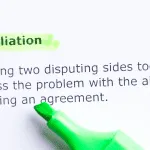
What is a Consent Decree?
The recent rise in consent decrees in the news, especially concerning policing, may have some people wonder what a consent decree is. Consent decrees may feel similar to other forms of settlement agreements, and they function similarly in some ways. Still, there are critical aspects to a consent decree that may be absent in other settlement agreements. Consent decrees have become popular lately as more police forces have decided to use them in use-of-force cases. Still, they have been around for some time in various kinds of law, such as antitrust, civil rights violations, discrimination, business law, and many others. Understanding what a consent decree is and the goals they seek to accomplish can help the parties in a lawsuit determine if it is the proper resolution method for them. This article will explain what a consent decree is, outline how they are achieved and how they work, compare them to other resolution types, and finally end with a discussion of standard forms of a consent decree. By reading this article, one will be prepared to approach a settlement conference or other resolution service prepared to know if a consent decree will give them the best option.
Consent Decree Explained:
A consent decree is a contract, or a formal agreement, between the two parties to a case that allows the dispute to be considered resolved, but it stops short of either party admitting blame for the dispute. It allows the parties to find a path forward, which is placed in a court order, meaning that the court may enforce the agreement between the parties. Considering this description, several characteristics stand out as setting a consent decree apart from other settlement agreements. These characteristics include:
- Fault: In many settlements, one party may admit fault, or there may be an inference of fault based on how the settlement is achieved. However, a consent decree is designed to avoid either party needing to accept or admit blame. This is particularly notable when dealing with cases where an admittance of fault would subject the person to other forms of punishment or fines, such as employment discrimination cases.
- Reform: consent decree requires that the parties establish a path forward for the dispute or a path for reform. The decree usually has a specific plan with steps for the reforming party and deadlines to hit those steps. This helps the parties realize that particular action will be taken, even if there is no assignment of blame.
- Order: A consent decree will be finalized in a court order. This means that the steps the parties have agreed on and the timelines will be enforceable by the court. Typically the penalties for failing to meet these deadlines will also be included in the decree, and the court can grant the penalty easily.
- Actor: A consent decree is most commonly brought against government bodies or businesses and usually occurs when a party asserts that the large party violated a law or regulatory code. However, they can be used in any case. But this adds to the appeal of the absence of blame because these larger actors often like to avoid a trial where it may be determined that they violated federal law.
- Binding: A consent decree is binding. Both parties agreed to abide by the decree; it cannot be appealed unless there was an issue with the creation of the contract itself, much like standard contracts. Common defenses to a consent decree are fraud, mutual mistake, duress, or lack of jurisdiction.
These characteristics set a consent decree apart from other forms of settlement. By creating a consent decree, the parties can outline the path forward, which can be a valuable way to resolve a dispute.
The Consent Decree Process and Enforcement:
When creating a consent decree, the parties are often focused on the reform aspect and making the decree enforceable. Still, if it is not preserved correctly, issues may arise when the parties attempt to enforce a provision of the consent decree. Therefore, to create an effective consent decree, the parties should consider the following steps:
- Agreement: Before they can even begin to consider drafting a consent decree, they must agree that a consent decree is the type of resolution they would like to achieve. Either party can bring it up, but both parties must agree to the decree.
- Negotiation: While the parties may have already decided that they would like to use a consent decree to resolve their dispute, they may still need to address the specific reforms that the parties need to put in place. This is where the parties will negotiate the particulars of the consent decree and what each party needs to do.
- Draft: Once the parties have agreed on the terms, they must draft the consent decree, which will look like a contract. This will outline the agreements the parties have made, the steps they would like to take, the timelines for the reform, and the specific assertion that blame will not be placed on either party.
- Submission: Once the parties have created the decree and signed it, it will be submitted to the court for final approval. The court should evaluate if the agreement is not glaringly unlawful or one-sided.
- Order: The decree will then be finalized in an order outlining the enforceable agreement. Creating this court order means that the federal judge oversees the completion of the reform agreement. This helps the parties feel that their agreement will be honored.
Once the order is completed, the parties will have a judicially enforceable, binding consent decree. Often, a federal judge will appoint a monitor to oversee the reform process and help resolve any issues that may arise before the parties need to resolve the issue in court. Typically, the monitor will ensure that the parties follow the plan by requesting regular reports. This can help encourage even the most reluctant parties to continue following the decree.
Compared to Other Settlements:
To further illustrate how a consent decree work, comparing a consent decree to other types of settlement options can be helpful. Doing so can explain the differences in the consent decree and why it is an important possibility for some parties. Other forms of settlement agreements are:
- Settlement Agreement: A standard settlement agreement may seem similar to a consent decree because it is a negotiated path forward from the settlement. While a consent decree is a form of a settlement agreement, not all settlement agreements are consent decrees because they may assign blame, may not include reform, or may not be signed by a federal judge. Ensuring the agreement includes all of the characteristics listed above will ensure that it is treated as a consent decree.
- Mediation: It is common to compare the agreement formed in mediation to a consent decree because they may have similarities. If a case has already begun, the parties will likely submit their mediation agreement to the court to be placed into an order resolving the case. However, not all mediation will occur during an active case and may not need to be put in court. Additionally, not all mediation will include a reform element.
- Judgment: A consent decree can feel like a judgment because it comes through a court order that has to be followed. However, judgments will often assign fault to one or both parties and decide the case accordingly, which is a major deviation from the refusal to blame that consent decrees should include.
Overall, the major characteristics of consent decrees that set them apart are the refusal to lay blame on either party and the reform aspect. Particularly in many mediations and settlement agreements, the parties are focused on resolving the issue, and the agreement reached will only focus on compensation, not future change. ReforOn the other hand, reform focuses on remedying the situation in the future, allowing the parties to feel confident that the dispute will not arise again.
Common Consent Decrees:
The following examples are common ways that a consent decree is used in different areas of the law:
- Antitrust Law: Antitrust law is a federal regulatory law that keeps companies from participating in certain practices that could influence free trade, such as creating monopolies and other interferences. A consent decree is common in antitrust law because it allows the company to continue to function without a charge of violating the laws. Still, a set plan is in place to help keep the company from threatening the violation again and ensure free trade.
- Employment: A consent decree is often used in EEOC and other employment lawsuits because it allows the parties again to find a path forward without finding wrongdoing, which many employers hope for because they do not want to ruin their reputation. Employment discrimination lawsuits can be lengthy processes and often result in many hard feelings between the parties. A consent decree provides a path forward for the parties where they can continue to work together, but the proposed settlement is achieved.
- Disability: The Americans with Disabilities Act (ADA) establishes various protections for people with disabilities. When this act is violated, many of the cases that result will end in a consent decree because these decrees will often compensate the person bringing the claim and ensure that the violator changes their practice moving forward, which helps effect change and encourage violators to work to get their facilities or policies under the law.
- Environmental Law: With disputes that arise under environmental law, the party that brings an allegation of a violation is typically looking to continue to protect the environment moving forward, so the reform aspect of a consent decree will often make sense. By forcing certain changes, the parties will ensure the environment is protected for years.
Several issues have arisen under American law historically that consent decrees have contributed to, including school desegregation and the Civil Rights movement. Yet consent decrees will not always remedy the solution, as the debate around consent decrees with police officers demonstrates.
A consent decree and Police Forces:
Consent decrees have gained more widespread visibility over the last decade or two as they have risen in popularity in police use of force or violence cases. These cases often involve the police department, the Department of Justice, and a judge. When the police demonstrate a violent display of force, the Department of Justice investigates the violence and the practices that the police force regularly uses to determine if the force’s policies encourage the use of force in discriminatory and unnecessary ways. The United States Department of Justice (DOJ) will often issue a finding of their investigation. However, encouraging or requiring change within the force has become a practice by having the parties sign a consent decree. The United States Department of Justice (DOJ) does not sign a formal charge but lays out a reform plan that the force must follow.
Theoretically, this type of agreement would be helpful because it encourages change within the force. However, the effectiveness in recent years as certain judges have yet to allow them to be enforced. Proponents of police reform have also criticized them because they do not always hold police forces accountable and do not hold them responsible for the harm they have already caused. This debate demonstrates the issues that may arise under a consent decree. Knowing that consent decrees can be helpful, but assessing the situation well can help the parties determine if it is the best possible option given the circumstances. When looking to affect both the past and the future, a consent decree can be an effective and helpful way to achieve that goal.
Must-read Articles:
- Understanding the Business Litigation Process - July 23, 2024
- Average Settlement Offers During Mediation - June 26, 2024
- Binding Mediation: An Affordable ADR Option - June 25, 2024


